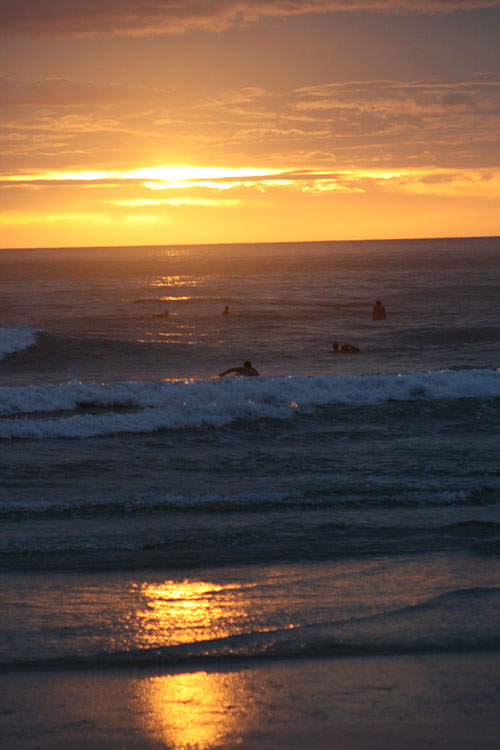SciGen Teacher Dashboard
Unit E4
Making Waves
 This unit introduces basic properties of waves and helps students learn to distinguish between the many types of waves they encounter daily. Students explore how the energy of a mechanical wave can travel through a medium.
This unit introduces basic properties of waves and helps students learn to distinguish between the many types of waves they encounter daily. Students explore how the energy of a mechanical wave can travel through a medium.
Activities
 Scene: Surf's Up (and Down, and Up Again)
Scene: Surf's Up (and Down, and Up Again)
Shani, Journey, and Luisa consider the nature of different kinds of waves as they watch their friend Kenzo surf.
Duration: Approximately 50 minutes
 Interactive: A Wave with Words
Interactive: A Wave with Words
Students go deeper into the meaning of different wave-related terms in this interactive, animated guide.
Duration: Approximately 55 minutes
 Lesson: Modeling Mechanical Waves
Lesson: Modeling Mechanical Waves
Students explore the nature of waves using several interactive and animated models.
Duration: Approximately 115 minutes
 Demo: Ripple Tank
Demo: Ripple Tank
Build a ripple tank for students to explore the properties of waves, use a wave simulator, and look for examples of wave reflection, interference, and refraction around the globe.
Duration: Approximately 70 minutes plus 30-minute exploratory extension
 Lab: Sound Stations
Lab: Sound Stations
Students deepen their understanding of waves through a series of quick experiments focused on the mechanical nature of sound. Students use a special combination keyboard and oscilloscope to examine the nature of waves.
Duration: Approximately 50 or more minutes
 Conversation: Waves of Danger
Conversation: Waves of Danger
Students use their knowledge about waves to interpret geological data, and then explore what makes some earthquakes (and their accompanying tsunamis) deadlier than others. They brainstorm how best to spend an earthquake preparedness budget.
Duration: Approximately 80 minutes
Student View of Visuals and Activities
Some teachers prefer to have students view the slides and other visual assets in this unit directly instead of projecting them in class. Below is a web page to share with students with links to some of same items that are within in the teacher lesson plans, but without the explanatory text for the teacher.
Teacher Tune-ups
Unit E4 Focus Words
wave
noun – a moving disturbance
Let's just stay put and wait for this wave to go by.
frequency
noun – the rate at which something repeats over time
I go to this beach with some frequency, because the waves also come with great frequency. More waves, more surfing!
amplitude
noun – measurement of highest point (or lowest point) in a wave when compared to its resting position
The amplitude of a wave increases with more energy.
trough
noun – the area around the lowest point of a wave; sometimes called a “valley”
While waiting for a wave to surf, it can be very relaxing to rise with each passing crest and slide into each passing trough.
crest
noun – the top of something; the area around the highest point of a wave; sometimes called a "peak"
Surfers stay a little ahead of the crest of a wave and slide down the front of it.
wavelength
noun – the distance in a wave between one crest and the next, or between two consecutive troughs
Waves with high frequencies also have shorter wavelengths.
compression
noun – the state of being squeezed or pressed together
Sound waves are compression waves. When we clap our hands, the air between our hands gets compressed. The air molecules bump into each other, creating a vibration that travels through the air as a longitudinal or compression wave.
medium
noun – a substance (like a solid, liquid, or gas) that the energy of a wave can travel through. In the example above, the medium is a flag.
All mechanical waves need a medium—such as water, air, or metal—to travel.
vibrate
verb — to move back and forth (or up and down) around a point; to shake with small, rapid movements to and fro.
Instruments make sounds when some parts of them vibrate, which moves the air molecules inside or around the instrument.
period
noun – a length of time
The period of one wave is the time it takes two crests to pass a point.
diffraction
noun – bending or turning of a wave around obstacles, or spreading out after the waves pass through small openings
Wave fronts bend as they go through a narrow opening, demonstrating diffraction.
refraction
noun – bending or turning of a wave as it goes from one medium to another, for example a light wave bending from air to water
Wave fronts bend as they approach a beach, demonstrating refraction.
BETA Version - Please send comments and corrections to info@serpinstitute.org